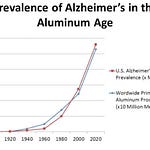BONUS NOTES:
The Real Anthony Fauci movie is free to view HERE.
Cassandra is censored off Amazon. Stay tuned, and I will tell you what happens.
To watch the entire Pacific Bitcoin conference free on YouTube, click HERE.
DISEASE-MONGERING & BOGUS CURES chapter from Butchered by “Healthcare,” available HERE.
I want to sell drugs to everyone. I want to sell drugs to healthy people. I want drugs to sell like chewing gum.
Henry Gadsden, former CEO of Merck, which developed some of the first medications that patients needed to take indefinitely (1976)
We expect hucksterism about the benefits of cars, clothes, and beauty treatments. But it surprises us when it comes from the medical industry, which uses identical marketing tricks. They frighten us with diseases to sell expensive drugs and treatments.
Here is how it works. Prominent physicians, guided by corporations, start with some ailment, real or imagined, and are paid to endorse therapies and drugs for it that are barely effective or sometimes even ineffective. But they do not stop there. They then promote more and more inclusive criteria for the “disease,” which creates more patients who need to take more medications and have more treatments. Finally, charity groups funded and controlled by the companies promote public awareness campaigns targeting both doctors and patients.
More specifically, drugs are used to treat blood pressure, cholesterol, and diabetes to avoid stroke, heart attacks, diabetic blindness, and other diseases. To accomplish this, physicians are guided by numbers for blood sugar, blood pressure, and cholesterol. The numbers considered abnormal are being continuously exaggerated to expand the group that supposedly requires drugging. This has made paying patients out of over half of us.
For example, the diabetes definition was originally a fasting blood sugar of over 140 mg/dl. This was changed to 126, which instantly gave diabetes—and drugs—to tens of millions of Americans who previously thought themselves healthy. Abnormal cholesterol went from over 240 to anything over 200. This also supposedly requires medications. The blood pressure considered treatable was originally over 160 for the higher (systolic) number. Now, anyone over 130 may get a medication prescription. None of these changes was dictated by substantial science, and all made a massive amount of money.
This has been established industry strategy for decades. Vince Parry explained it in Medical Marketing & Media (2003). He gave this conspiracy gravitas by dubbing it “Condition Marketing:”
There are three principal strategies for fostering the creation of a condition and aligning it with a product:
■ elevating the importance of an existing condition
■ redefining a current condition to reduce a stigma
■ developing a new condition to build recognition for an unmet market need.
The expense and anxiety of having a diagnosis are not the only problems for patients. Sometimes the wrong treatment is performed, and sometimes surgical complications occur. Prescription medications are a major source of errors and even deaths. The Institute of Medicine states that medication errors are the cause of demise for one of 131 outpatient and 1 of 854 in-hospital deaths.
Lower blood pressure occasionally causes fainting, which is a disaster when driving. Drugs that lower blood sugar can cause blackouts or even death. Cholesterol medications create a host of problems, including occasional deaths because of muscle damage.
Drugs may be worth the risk of side effects for sick people whose disease process is being treated. However, people who take drugs unnecessarily enjoy none of the benefits. They still suffer side effects, which are the only effects for them. Anyone not stuck in the tar-pit of recent medical thought would think this was beyond obvious. Drugs, treatments, and lab tests must be reserved for the ill, who have symptoms. The following diseases show how far our current practices have departed from this simple, traditional standard.
Diabetics cannot absorb sugar (glucose) from the blood into the body properly. This causes high blood sugar levels that, over time, produce blindness, heart attacks, kidney failure, and even death. The discovery and use of insulin to facilitate glucose absorption and thus lower blood sugar levels are among medicine’s finest achievements.
People with childhood or type 1 diabetes cannot get glucose out of the blood into the body because they make no insulin. They require daily injections to survive. People with type 2 diabetes, who are mostly older, still produce it, but their bodies are resistant to its effects. We treat them with diet and oral medications to decrease their blood levels, and some doctors give them insulin. The benefits of drugging this group are controversial, especially for insulin and especially in older patients.
The new, expensive oral medications for type 2 diabetes are associated with increased heart attack deaths. Despite their high cost, patients taking them do not live longer than those on the older diabetic medications. This should have eliminated their use altogether.
Avandia was probably the worst offender in this class, yet by 2006 the drugmakers promoted it into becoming the highest-earning diabetic drug in the world. It lowers blood sugar, but as with the others, it increases heart attacks and deaths. Thirteen thousand lawsuits have been filed against the manufacturer, and they settled 11,500. Endocrinologists have been vocal in opposing it, and it is no longer available in Europe, but the drug is still sold in the US. (For more about Avandia, see drugwatch.com, the BMJ, the New England Journal of Medicine, and Peter Gøtzsche’s Deadly Medicines and Organized Crime.)
The profits from these medications defy imagination. Their worldwide revenues, including the insulins, were $27 billion in 2008 and $71 billion by 2015. This involves many companies. Dr. Gøtzsche reported (2013) that the manufacturers structured the studies of the newer oral blood sugar drugs to conceal fatalities (ibid). Rather than carefully testing patient outcomes, the trials looked at surrogate numbers such as sugar and hemoglobin A1c, which is a measure of glucose values during the three months before the test is performed.
Metformin was first used in 1922. It helps with weight loss, lowers blood sugar, and lowers hemoglobin A1c. It does not create hypoglycemia when used alone and likely decreases deaths and heart attacks. Lifestyle changes should always be tried first for type II diabetes, but if any drug is used, metformin is the cheapest and safest. The recently patented drugs are not an improvement.
Likewise, the purpose of blood pressure control is to prevent heart disease and stroke. The Cochrane Collaboration (2012) looked at the studies and saw no evidence that reducing blood pressures below 160/100 improved health. In 2018, they evaluated studies of patients with heart and vascular disease and found the same thing. For older adults, another review (2017) found no evidence that the lower numbers helped either.
The massive SPRINT study published in 2017 supported tighter blood pressure control. Although this was primarily a government-funded trial, detractors pointed out that the study design was flawed. They also used wrong blood pressure machines, and some calculations were in error.
The American College of Cardiology (ACC) at one time defined high blood pressure as higher than 160/100. They dropped this to 140/90, and then in 2017 to 120/80 for some patients. The American Heart Association has the nerve to disease-monger this latest guideline using photographs of men who have scars down the center of their chests after coronary artery bypass grafting. The ACC is threatening a monstrous surgery that seldom helps anyone if people cannot get their blood pressure down to a reading that makes no known difference! Our patients are now racing to the emergency room in fear of strokes if they see 160/100 on their home blood pressure machines.
Everyone seems to have forgotten that statin anti-cholesterol medications are another attempt to prevent heart attacks. But the FDA approved them solely because they changed numbers. The vast majority of patients using statins have no known heart disease and no other issues. These patients do not live any longer. A study published in PLOS (2016) looked at over a million person-years of data and concluded the drugs are prescribed for many who do not benefit, and that the prescribing guidelines are wrong. In women, they slightly reduce the risk of events such as heart attacks, but they do not improve longevity (1998). The JUPITER trial, published in 2009, confirmed this. This information is ignored.
If 83 men who have already had a heart attack or another cardiac event take the drugs for five years, one in 83 will have his life saved, but the medications cause muscle damage in one in 10 and diabetes in one in 50. For the rare case of hereditary high cholesterol, defined as about twice normal, there are also slight advantages. But for the vast majority, statins cause more harm than good. At least 18 percent of users have a recognized side effect. These include sexual dysfunction and Parkinson’s disease (Worried Sick, Nortin Hadler). One in 204 gets diabetes. Muscle damage occurs in one in 21, and this is occasionally fatal (Citizen Patient, Nortin Hadler).
Despite this, the industry wants us to use statins routinely for healthy people. Their excuse is that the drugs prevent heart attacks and strokes in a few—despite not affecting lifespan. Guidelines from the American College of Cardiology and the American Heart Association (2013) recommend that 12.8 million Americans and a billion people worldwide take the drugs. Over half of the committee members who invented this idea had a financial connection with the pharmaceutical industry.
The FDA approved the drugs for children with hereditary high cholesterol, defined as about twice-normal for both total and “bad” cholesterol. The studies have never shown a longer life span for treated children. Yet the pediatric society recommends checking cholesterol three times during the years from 2 to 18, citing the obesity rates as justification.
TheNNT.com is a website devoted to summarizing which treatments work and which do not. They promote a simple way to understand statistics—calculating the number of people that are needed to be treated to produce one beneficial patient effect. They say the following about statins: “Virtually all of the major statin studies were paid for and conducted by their respective pharmaceutical company. A long history of misrepresentation of data and occasionally fraudulent reporting of data suggests that these results are often much more optimistic than subsequent data produced by researchers and parties that do not have a financial stake in the results…”
John Abramson reviewed the situation in The Pharmaceutical Journal in 2015. Like theNNT.com, this is for an academic audience. His sense of outrage percolates through his careful verbiage: “The bottom line is that practically all that we think we know about the efficacy and safety of statins has been brought to us by commercial interests that hold the actual data as proprietary secrets… we cannot verify commercial claims of efficacy and safety.”
The purpose of osteoporosis treatment is to prevent fractures, which have a relationship to fatality. Half the women over 50 will get an osteoporotic fracture, and by the time Americans are 65 years old, 20 percent of all of us, 300,000 per year, will have broken our hips. For women, 14 to 58 percent die within a year according to various studies. The annual deaths from breast cancer are about 42,000, which is roughly similar.
Do these deaths related to hip fracture occur in already debilitated people, or do the breaks cause deaths or both? The answers are not clear, nor are the benefits of the therapies we use. But since fractures in the elderly are a major problem, prevention of some sort seems reasonable to nearly everyone.
Bisphosphonates are promoted for the prevention of bone thinning, but they are worse than nothing. They are expensive, ineffective, increase fracture rates, and even cause rotting jawbones for some people. TheNNT.com summarized the data, quoting a Cochrane meta-analysis. They say the drugs are ineffective for women without prior fractures and that they prevent fractures solely in the small group of women who have both osteoporosis shown on a scan plus a previously broken bone.
By 2009 there were 1200 lawsuits against Merck over the irreversible decay of the jawbones with Fosomax, one of these medications. A recent article on drugwatch.com says 1200 cases of femur fractures and jaw necrosis had been settled for a total of $28 million. Although the original studies were statistically manipulated to show an overall decrease in bone breakage, this drug likely increases femur fractures. Atrial fibrillation, a disordered heart rhythm, was seen more often when people took the drug. Over 40 side effects are listed on one website. Most people hate these medications because they make them feel horrible.
Despite all this, the drug industry aggressively promoted bisphosphonate drugs using the standard methods of disease-mongering and diagnosis-creep. It all began at a Rome medical meeting in 1992 when the doctors concocted the pre-osteoporosis state of “osteopenia.” They defined this as decreased bone density found on a radiologic study, diagnosed using an invented threshold, and without symptoms. The manufacturer released Fosamax, the first drug to treat it, at about the same time. Although you can find contrary information about the controversies on the Internet, there is no proof these drugs decrease clinically significant fractures.
Merck, the Fosamax manufacturer, began building thousands of machines to permit physicians to check bone density in the wrist or other areas of the arms or legs. However, although bone density in the spine or hip predicts fractures, these locations do not. Merck got the machines FDA-approved, funded leasing programs for physicians, and somehow the scans were soon reimbursed by Medicare. The drugmaker understood that when physicians made money doing scans, the entire scam would blast off. In further marketing ploys, Merck launched a nonprofit, the Bone Measurement Institute, along with a massive disease awareness campaign. Soon, nearly every woman had something more to worry about.
The entire thing seemed credible to the US Preventive Services Task Force (USPSTF). Their process is to select a handful of doctors and have them vote on an issue. Despite the dubious history, they put together a group who ratified the use of these drugs for osteopenia, this symptomless scan finding which has only a theoretical relationship to fracture.
Merck was still not content. They were soon able to liberalize the bone density numbers considered diagnostic for their invented disease. Medical standards (in this case medical mythology), now recommends these drugs for 52 percent of all senior women. Sales have soared, of course.
Drugs administered in the office like this may yield commissions of up to 20 percent for treating doctors. Physicians are incentivized to push the most expensive options on their victims (I meant patients). Financial conflicts of interest make it difficult for doctors to do the best thing for their patients. If these medications were purchased from other physicians, payouts like this would be felonies. We permit doctors to abet corporations in their misconduct but have not classified it as criminal for either side (see the Failed Cancer Treatments chapter for more).
Tens of millions of women now use these risky bisphosphonates. Fosamax alone sold about $3 billion in 2007 before it went off patent. This declined to $284 million by 2016, but other drugs replaced it. There are now ten of these medications with many manufacturers. Even though their popularity declined somewhat after their tendency to cause fractures became well known, the cost is many billions of dollars a year.
The corporations and their paid supporters claim that their Tamiflu flu treatment decreases symptoms and prevents complications such as pneumonia. But the best estimate of benefit is that it may save a half-day of sickness per individual per dose when prescribed immediately after the start of symptoms. This is nearly impossible. The FDA's longstanding opinion is that Tamiflu did not affect complications, hospital admissions, or survival. It prohibited the manufacturer from making these claims.
A 2014 Cochrane review concluded the drug was worthless (my personal interpretation 0f their work). They included many studies not sponsored by industry. Two meta-analyses said risks were higher than the benefits. Within a day of getting the drug, panic attacks, delusions, convulsions, and even suicide have been reported. Complete information is scarce, however. Study data withheld by the manufacturer would reveal the entire truth, but so far, there have been no legal challenges to get it. Industry sources, including John Bell (Professor of Medicine at Oxford), stonewalled Cochrane’s requests for access to Roche's unpublished Tamiflu studies. He was on the board of directors for Roche, and they paid him €322,450 in 2011.
Well-referenced reviews in the Huff Post and the Atlantic report that Tamiflu does not decrease the chances of pneumonia or other severe illnesses. They also describe the obscene marketing—or rather mongering—by Hoffmann-La Roche and the Centers for Disease Control (CDC). Despite all this, the medication had $18 billion in sales (2017). The US, Britain, and other countries were somehow cajoled into stockpiling billions of dollars’ worth.
The CDC itself is compromised by millions of dollars in pharmaceutical company donations. They claim, however: “Our planners and our content experts wish to disclose they have no financial interests or other relationships with the manufacturers of commercial products… [the] CDC does not accept commercial support.” Stephen A. Sheller, a Philadelphia lawyer, said “The CDC is a disgrace. It is a corrupt organization… the drug companies have them on their payroll." Their leaders go back and forth between their government and industry jobs and buy industry stock while they are working for the Agency.
The label scamiflu instead of Tamiflu went viral on the Internet. A UK National Health Service analysis (2014) agreed: “The modest benefits of Tamiflu… do not justify the increased adverse risks, let alone the money spent on them.” The WHO belatedly removed Tamiflu from their essential medications list in 2017.
The flu vaccine, just like Tamiflu, supposedly prevents pneumonia and other serious problems for those who are old or sick. Cochrane had grave doubts about this, however. They reviewed 90 flu vaccination studies and considered less than 10 percent of them decent science. Industry primarily funded the trials. Cochrane said:
Inactivated vaccines can reduce the proportion of healthy adults (including pregnant women) who have influenza and influenza-like-illness, but their impact is modest. We are uncertain about the effects of inactivated vaccines on working days lost or severe complications of influenza during the flu season.
Despite this, the Centers for Disease Control (CDC) recommends the vaccine for nearly everyone and the World Health Organization (WHO) recommends it for vulnerable groups. Many hospitals shame nurses who refuse to get vaccinated into wearing surgical face masks, and a few even get fired. This is a $4 billion industry worldwide, and $1.6 billion is spent in the US.
Xigris was a drug for sepsis, which is an overwhelming infection that most often affects people at death's door. A split vote of an FDA advisory committee approved the drug after a single study purported that it worked. Eli Lilly was hoping for a billion-dollar blockbuster, and in 2001, they claimed the drug was “one of our industry's genuine breakthroughs.” Their charges were $8,000 per patient.
The company hired a PR firm, who recommended they boost demand by claiming that Xigris was in short supply and needed rationing. This is the scarcity marketing ploy: buy it now; it is nearly gone. Eli Lilly's public relations firm started Surviving Sepsis, a nonprofit group supposedly representing patient interests. Lilly funded a campaign with the same name. Doctors with financial ties to Lilly created guidelines for the medication’s use. Despite all this disease-mongering, they withdrew the drug in October 2011 because it was ineffective. Cochrane reported (2012): “All trials had high risk of bias and were sponsored by the pharmaceutical industry (Eli Lilly). We found no evidence suggesting that [Xigris] reduced the risk of death in adults or children with severe sepsis or septic shock. On the contrary, [it] increased the risk of serious bleeding.”
Strokes occur when blood clots, cholesterol, or bleeding block parts of the brain's circulation. This causes brain dysfunction and sometimes partial or complete brain death.
“Clot-dissolving” medications (intravenous thrombolytics/tissue plasminogen activator/TPA) are FDA-approved for heart attacks. They occasionally help if given early. However, the emergency treatment of a stroke with these agents is questionable. A 2013 review showed no improved survival and some patient harm. Despite this, the FDA approved stroke treatment with these drugs.
Cochrane's 2009 report of 26 studies said the drugs produced, “an increase both in deaths (evident at seven to ten days and at final follow up) and in symptomatic intracranial haemorrhages.” But in 2014, Cochrane reversed their opinion and said thrombolytic therapy was valuable if given in the first six hours. Since they had added only one inconclusive study to the primary analysis, this conclusion outraged knowledgeable commentators, who speculated that industry financing had infiltrated Cochrane.
These medications cost tens of thousands of dollars per patient wholesale. The hospital retails them for astronomically more. If knowledgeable physicians refuse to give them, hospital administrators may ask less ethical doctors to write the order. I interviewed Jake, the chief emergency physician for a group that believed intravenous thrombolytics do not work for stroke. His team told the hospital administrators they would not use them. So the hospital hired neurologists to Skype the emergency nurses and order the medicine hooked up. It costs $25,000 per patient just for the drugs, and the neurologists get paid just for phoning it in.
Jason is a radiology technician at another Los Angeles hospital. He told me the same story about the same specialists in his hospital’s emergency department.
Prostate cancer treatment with Lupron is one of urology’s embarrassments. This is a “chemical castration” medicine, approved in 1985 to treat metastatic prostate cancer. It did not sell well until the company figured out a way to pay off the surgeons. They developed a long-acting monthly shot, and urologists could buy it wholesale and retail it in their offices. This was a nasty conflict of interest that makes patient care secondary.
The company increased the temptation further by giving the doctors samples. This enticed them to sell the freebies to patients and keep the money, which is illegal. Medicare paid $1200 for one of these shots. Urologists could make several hundred thousand dollars a year on this. Internally, the manufacturer called these doctors their “drug whores.” Lupron treatments accounted for 40 percent of all Medicare payments to some of these practices in the late 1990s.
After a whistleblower lawsuit and years of litigation, federal prosecutors settled this “nationwide conspiracy” with the manufacturer for $885 million. No corporate executives went to prison. The industry now skirts illegality by paying doctors an administration fee for using Lupron instead of providing free samples.
The worst part of this story is that Lupron is an atrocious drug. Men feel terrible, get hot flashes, and become impotent. Some have weight gain, fatigue, muscle loss, anemia, Alzheimer's disease, and osteoporosis. It also causes strokes, heart attacks, diabetes, and sudden death.
Otis Brawley, former head of the American Cancer Society, says men are dying earlier because of Lupron therapy. This drug and others have decreased prostate cancer deaths by 30 percent since 1990, but all-cause deaths may have increased because the drug is so toxic:
Widespread use of [anti-] hormonal agents is causing men to die of cardiovascular disease and diabetes before they would ordinarily die of prostate cancer. That’s what I suspect is taking place. If urologists stop prescribing these drugs as widely as they used to, we will see deaths from prostate cancer inch up. That could be good news. Some men who would have died earlier with strokes and heart attacks caused by hormonal treatments of their asymptomatic disease would now live long enough to die of their prostate cancer.
How We Do Harm (2012)
My friend Paul had his PSA checked every year. When he was 73, it jumped up to 10. Even though Paul felt fine, he went off to see the urologists, who obligingly biopsied his prostate. They found a tumor and now use a Lupron shot every few months to “block” his testosterone. Medicare pays them a nice injection fee. Paul feels terrible because his testosterone levels are low.
Estrogen is likely a far better treatment. It is cheap; it works for many, and it has few side effects. Fifty years of experience shows it controls metastatic prostate cancer and does not feminize men. Since the companies cannot patent substances identical to those in the human body, they do not promote drugs like this. (Occasionally, delivery systems such as the estrogen patch or a supposedly unique drug strength is used to justify patent protection. For these medications, windfall profits can still be made.)
I’m not sure where drug marketers can go next. They already claim that nearly half of us have pre-diabetes, and forty percent of us have high cholesterol. One in six US citizens has already started on psychiatric drugs, for the claim is that half of us or more will have mental diseases during our lifetimes. The next few chapters show how they bully consumers and competitors and pull other dirty tricks to make more money.
NOTE: We soon found out where the drugmakers could go next—this was published right before COVID.












Share this post